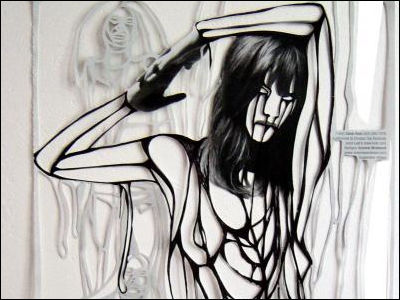Facebook's avatar creation technology is too much to talk about 'indistinguishable from the real thing'
Facebook has published a technology called " Codec Avatar " that can reproduce real human faces and expressions in real time in the world of VR (Virtual Reality). The nature of this avatar's movement is astonishing, and it is possible to imagine the future of people living in the world of virtual reality.
Facebook Can Make VR Avatars Look—and Move—Exactly Like You | WIRED
https://www.wired.com/story/facebook-oculus-codec-avatars-vr/
You can check what kind of VR avatar on Facebook from the following movie.
FACEBOOK CAN MAKE VR AVATARS LOOK-AND MOVE-EXACTLY LIKE YOU-YouTube
A woman's face that changes expression on the screen.
At first glance it looks like a video shot of a human being, but in fact it is an avatar created by Facebook Reality Labs that incorporates machine learning technology. It is called "codec avatar" in the lab.
The left of the white line is the real female face, and the right is the avatar.
The face of a real woman looks like this. Although the texture is slightly different, changes in expression etc. are real. It is said that artificial images resembling human beings become more eerie if they resemble human beings, but avatars do not feel spooky, and the word "nature" comes to mind.
Male version. The left is a real man and the right is an avatar. It is a real thing although there is an impression that is a little poor in expression.
I feel like this when I change my expression.
Besides, avatars created by various people are as follows.
Facebook Reality Labs changed the name of Oculus Research, a research and development center originally owned by Oculus, a subsidiary of Facebook. It is assumed that avatars are used for communication using VR headsets, and if realized, more realistic conversations should be possible in the virtual world.
In the movie, a person in a virtual world was actually shown using VR headsets.
You can see that head movements and expressions are linked in real time. However, there was an impression that the avatar could not be reproduced if the size of the expression exceeded a certain range.
This is how you capture a face to create an avatar. This capture device is called "Mugsy".
This avatar technology was published by a writer and interviewed by WIRED's senior correspondent Peter Rubin . Yaser Sheikh, representative of Facebook Reality Labs in Pittsburgh, Pennsylvania, USA, said that as of March 2019, "There is no plan to release the technology to the public," "it will be released several years from now. I will say.
Many people agree that codec avatars are a great technology, but in recent years deep fakes have been viewed as problems, and codec avatars have similar problems as deep fakes. There is a concern that fake news will become even more true and the possibility of violating privacy will be increased if AI can create "faces" freely. If VR and AR become commonplace with communication platforms like Facebook, the problem gets even bigger.
She agrees on this point, saying, "This technology's 'closeness to real' is important for success, but at the same time it's also important to 'protect the user'". The development of certification systems that prove their identity is also urgently needed, and she needs to create certification methods that incorporate ecological features such as eyes, voices and habits, she said.
Related Posts:







